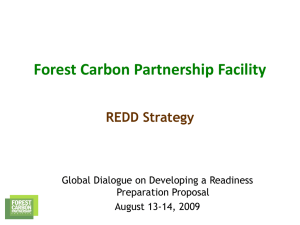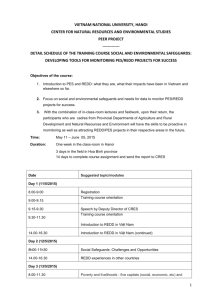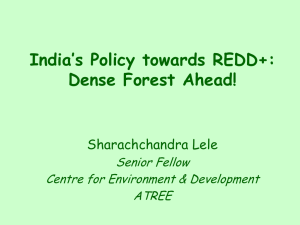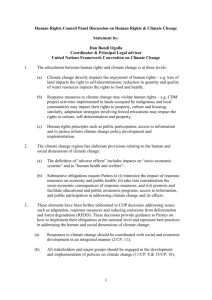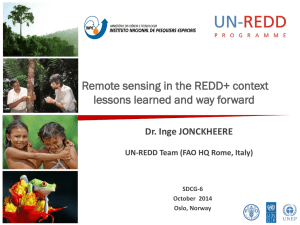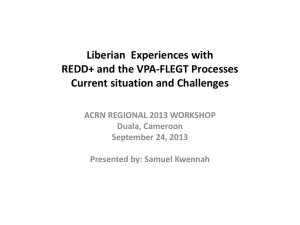Workshop Objectives - International Institute for Sustainable
advertisement
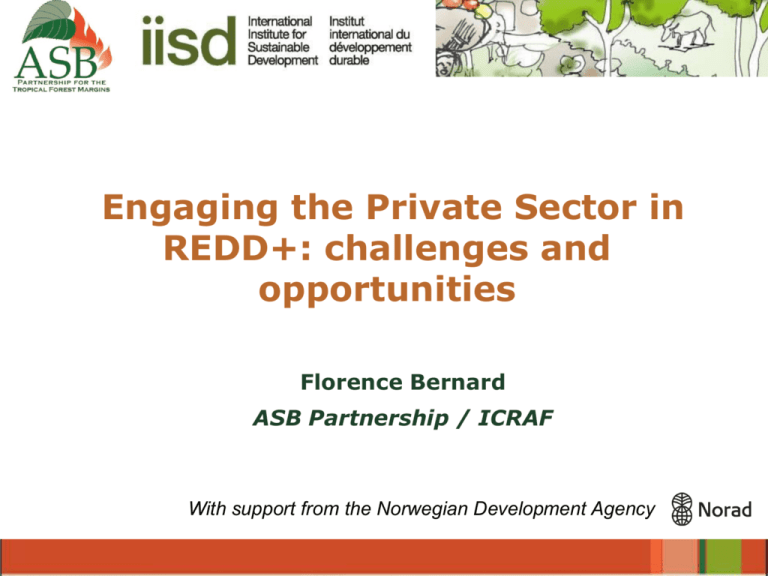
Engaging the Private Sector in REDD+: challenges and opportunities Florence Bernard ASB Partnership / ICRAF With support from the Norwegian Development Agency Presentation outline 1. 2. 3. 4. Research objectives Research methodology Durban agreements Initial key findings – Who is the private sector? – Private sector in the REDD+ value chain and motivations – Private sector perspectives – Government perspectives 5. Key questions Research objectives • Goal: Improving REDD+ outcomes by fostering successful private sector engagement. • Outcome: Enhanced understanding of current and potential future contributions of the private sector to REDD+ initiatives, and identifying key components of effective private sector engagement. • Output: A policy paper outlining the key lessons learned for successful private sector participation in implementing REDD+ initiatives. Research methodology • Comprehensive desk review • Semi-structured interviews with key informants at the country and project level (11 interviews conducted) • Review of 16 selected projects : Kenya (2), Cameroon (1), Tanzania (4), DRC (2), Madagascar (2), Zimbabwe (1), Vietnam (2), Philippines (2). Private sector is a key component in moving forward • Financing gap between current public funding commitments ($4.5bn) and the amounts required to significantly reduce deforestation (estimated at $17bn - $33bn) • COP 17: Private sector sources “could be developed” to fund project activity; financing “may come from a wide variety of sources, public and private, bilateral and multilateral, including alternative sources” and “appropriate market-based approaches could be developed” • Green Climate Fund : “private-sector facility” intended to enable the sector to finance private-sector mitigation and adaptation activities • Appropriate means and scope of private sector involvement, going beyond financing Who is the private sector? • Definition : all of the paradigm cases of private firms, including sole proprietorships, partnerships (general, limited, or limited liability), corporations (privately owned or publicly traded), cooperatives and franchises • Diverse array of firm sizes, structures and operations that range from the purely local to national, regional and international in scope. • Not-for-profit ventures, non-governmental organizations and charitable foundations will be treated as a “third sector”. Private sector in REDD value chain and their motivations (i) Producers through project development and investment • • • Some medium to large-sized private firms (e.g. Wildlife Works) Large multinational firms motivated by CSR (e.g. Walt Disney Corporation) REDD+ investors not developing projects themselves (e.g. Althelia Climate Fund and Ned Bank) (ii) Advisors through capacity building and technical development • (iii) Brokers through carbon credit trading and retailing Private consulting • companies for capacity building and technical development services (e.g. PDD, establishing Reference Levels, MRV or the accreditation processes) Small number of companies (e.g. Carbon Neutral) (iv) End buyers through carbon credit purchasing • • Companies that are major emitters : to offset their own emissions and reach ‘’carbon neutrality’’ A lot of CSRmotivated companies Strategies to incentivize Private Sector investments and create demand for REDD+ ER credits • Number of new multimillion dollar private REDD+ investment funds have been established (e.g. Althelia ($250m), Macquarie-IFC ($25m+), Terra Global Capital ($50m+)) • Compliance markets, including new and emerging compliance markets such as the Australia and California cap and trade systems. • REDD+ delivering more and more VCS and CCB standard carbon credits which are likely to be used to access some compliance regimes • REDD+ opportunities should be brought to the attention of banks, insurance companies, large companies with a CSR orientation, customer sales, event management companies. The private sector requires a conductive regulatory, institutional and policy framework and active government support in protecting their investments • Need for a strong policy signal such as a national REDD+ strategy and incentive structures to be put in place to drive REDD+ • Level (national or project) of the performance-based payment, question of payments for overall national performance versus projectlevel performance and risk mitigation mechanisms • Need for a clear land tenure system • Issue of the non-permanence of emissions reductions which needs further insurance The government also needs some guarantees from the private sector to enable their engagement • Carbon rights: an agreement and Benefit Sharing Mechanism (BSM) needs to be developed • Forest rights: there is a need for a clear understanding of the implications and impacts for the communities’ access to forest resources • Land rights have to be clarified to avoid land-grabbing and appropriation • Potential role of broker raises fairness or equity issues • Need to develop appropriate social and environmental safeguards Key questions 1. Who are the private sector players, what is their type of intervention in the REDD+ value chain, and what are their motivations? Question Components What are the prevailing current trends of private sector involvement in REDD+ initiatives? What can be the role of private sector across the value chain? What is the main motivation of the private sector and how does this vary between firms? How does the private sector interact with different jurisdictional levels and what could be the future of these trends? Key questions 2. What strategies / best practices should be developed or promoted to incentivize private sector investments in REDD+ and to create demand for REDD+ emissions reductions credits? Question Components Should REDD+ be allowed to access compliance markets within a future post-Kyoto regime? Under which modalities? What are the characteristics that could make REDD+ particularly appealing to the private sector and what types of strategies could be devised for increasing their appeal? How to create a business case beyond corporate social responsibility and voluntary action? Is there a need for marketing studies to scan all potential investors and buyers in REDD+, gauge and build interest, at local, national and international levels? Key questions 3. What are the aspects of the overall regulatory, policy, and institutional environment that need to be addressed to enable greater collaboration between the public and private sectors on REDD+ initiatives? Question Components What are the main barriers to overcome and the priority measures to develop in order to tackle expectations of the private sector and government/third parties? Is there a need for engaging the private sector in the policy arena to build a workable framework? Which types of safeguards should be developed to circumscribe private sector activities without serving as too great a disincentive? Socio-economic International context Regulation/Policy Framework Global National REDD Value Chain SubNational Thank you for your attention and now… Sharing your thoughts and ideas!



